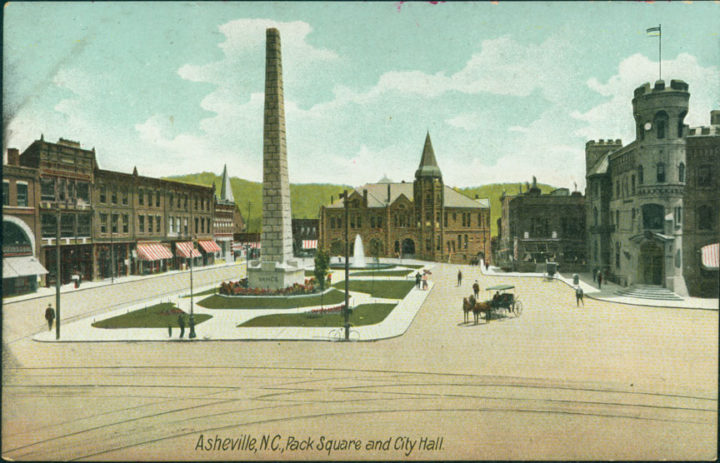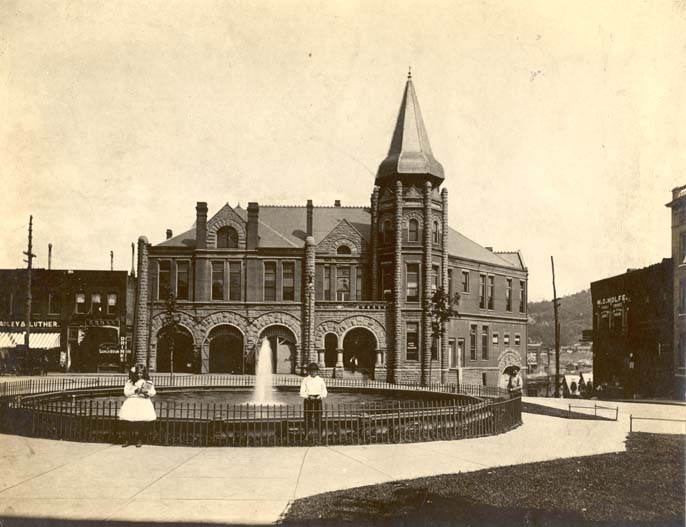On March 20, 1926, The Jackson Campbell Co. took out an advertisement in The Asheville Citizen. In it, the real estate company paid homage to an old landmark. “The City Hall Building was for many years a sort of beacon for the citizen,” the advertisement declared. “[T]oday it is being razed to make way for progress.”
Thirty-six years earlier, in September 1890, J.A. Tennent was authorized to manage the building’s construction. The multistoried structure would house a number of city departments, including the mayor’s court, City Council chambers, Fire Department and jail. It would also feature a market in its basement. Work began in late fall.
By spring 1891, however, Mayor Charles D. Blanton suspended further construction in response to a signed petition. On May 21, the Asheville Daily Citizen shared the petitioners’ complaints. Residents objected to the proximity of the market to the fire station; they also contested the market’s placement in the building’s basement, stating it was an inconvenient and inaccessible location.
The newspaper disputed both claims. “[T]he fire department as proposed will be 50 feet from the nearest entrance to the market,” it asserted. “[T]here can be no reason to supposing that crowds will congregate around the doors, to be run over by the horses in case of an alarm of fire.” With respect to accessibility, the paper pointed out that there were eight different entries available to people visiting the market.
The mayor and city aldermen ultimately agreed with the Asheville Daily Citizen‘s assessment. On May 30, construction resumed.
Local pride soon replaced consternation and complaint. In August, one resident wrote to the paper proclaiming that the new City Hall would be “one of the prettiest, if not the prettiest buildings in North Carolina.” The following month, another resident echoed the previous author’s claim, writing, “Our new City Hall will be the handsomest structure in the State.”

That same month, the paper reported on the dire need for the new market. Until its completion, the Asheville Daily Citizen declared, “there is really no place where the wood, fruit and huckster’s wagons can stand and feel at home.” At the time, the paper noted, 18 wagons occupied the northern side of the square, impeding foot traffic.
Wagon owners also left behind quite a mess, one angry resident wrote in a Sept. 3 letter to the paper: “Rinds, manure and rotten slimes and shells line the square all the way up and down. … I know of a party of three families who refused to board in Asheville because of the stink and stench of its streets.”
Construction continued throughout the winter and spring. Finally, in July 1892, officials began moving into their offices at the new City Hall. Along with employees, local prisoners were also transferred to the building’s new jail (with a man known as “Squirley” Anderson earning the title of “first occupant”).
Decades later, on April 18, 1926, with the building’s demolition underway, The Sunday Citizen remembered the pride which preceded its destruction. The paper wrote:
“With its turrets and towers, its brownstone front and pressed brick walls, the pile was in its day a thing of splendor. All of which may go to show that along about 1960, Asheville folks who are now pointing to some of the gorgeous glories of its admiration may be lifting an index finger in the same direction with sneering scorn.”
The 1892 City Hall was replaced by the present-day, Douglas Ellington design.
Editor’s note: Peculiarities of spelling and punctuation are preserved from the original documents.




Really enjoy the Archives, as much for the samples of gloriously descriptive writing (like the quote at the bottom of this article) as for the information and photos.
“Asheville folks who are now pointing to some of the gorgeous glories of its admiration may be lifting an index finger in the same direction with sneering scorn.”
“And by 2018, they will have routinely replaced that finger with another.”
If I’m not mistaken, the jail referred to in that description still exists. The large Magnolia tree in front of today’s City Hall sits atop it. The County’s 2006 sale of the “Old Jail” property as it is called, is what set the whole Parkside debacle in motion. We fought for three years to stop Stewart Coleman from putting condos there.
https://mountainx.com/news/community-news/the_end_of_parkside_coleman_withdraws_project/
What prompted the County staff to recommend selling that property in the first place? Rumors suggested that it grew out of the fight over water. At the time, County and City were fighting over the dissolution of the Water Authority. Apparently, County staff thought it would be hilarious to mess with the City by selling a piece of parkland in front of City Hall off to a developer. Another piece of Wanda Greene’s legacy…
Speaking of the Asheville jail, and how stories in this town always seem to be interrelated, I’ve always wondered if this story had anything to do with things that happened later…
Moffitt v. . Asheville, 9 S.E. 695 (N.C. 1889)
https://www.courtlistener.com/opinion/3907507/moffitt-v-asheville/